DeFAI has cut 70%, are there any investment opportunities?

Reprinted from panewslab
02/07/2025·17DWritten by: Squid
Compiled by: Luffy, Foresight News
After the market experienced a sharp drop, let’s take a look at where the real opportunity lies.
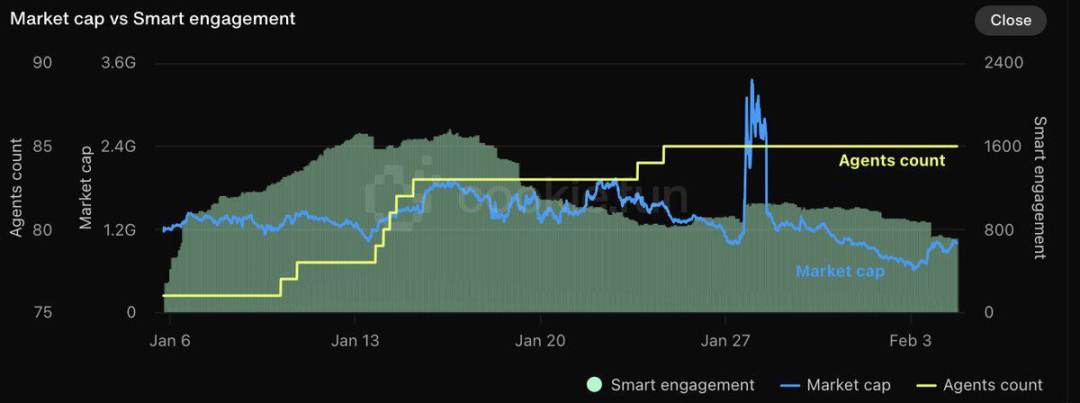
In the past two weeks, DeFAI\'s market value has fallen by more than 50% compared with mid-January and 70% compared with its peak in late January. The data comes from @cookiedotfun.
Decentralized finance (DeFi) is now a US$125 billion market. Assuming DeFAI accounts for 10%, it means there is still 15 times the growth opportunity. In fact, I think there are greater opportunities in the DeFAI market, because the current pricing in various segments is not reasonable.
Recently, we have witnessed an epic cryptocurrency clearance. During this period, assets were sold out regardless of their pros and cons. Artificial intelligence (AI) and DeFAI are among the hardest hit areas.
Now is the time to find treasures, let's take a deeper look.
Why is DeFAI so popular? First, we look at the combination of cryptocurrencies and artificial intelligence from a broader perspective. The combination of cryptocurrency and artificial intelligence is a $10 billion market that urgently needs to find "utility", and DeFAI seems to be the area where practicality is most likely.
For most of these crypto-agents, the product is their token. Because of this, we see that the highest areas of product market fit (PMF) are those frameworks that allow teams to easily launch tokenized social agents and Launchpad (project launch platform). As the token supply grows exponentially, this market is becoming saturated, and the demand for social proxy tokens and Launchpads will also decrease, and the community has to work hard to look forward to new development directions.
Sliding towards the hockey (to go with the flow)
From a macro perspective, DeFAI is of practical significance. This field is the intersection of finance, one of the most unmet needs of cryptocurrency, DeFi and artificial intelligence.
That being said, just because this field makes sense from a macro perspective, it doesn’t mean that every project can work. Let's explore more deeply and see where opportunities may lie.
Looking at the recent DeFAI market map, most of the projects launched have limited practicality in DeFi. I think this is due to the novelty in the field and the time it takes to build the project.
People want to get tokens, and most of the projects launched so far are targeting the easiest to achieve but least practical.
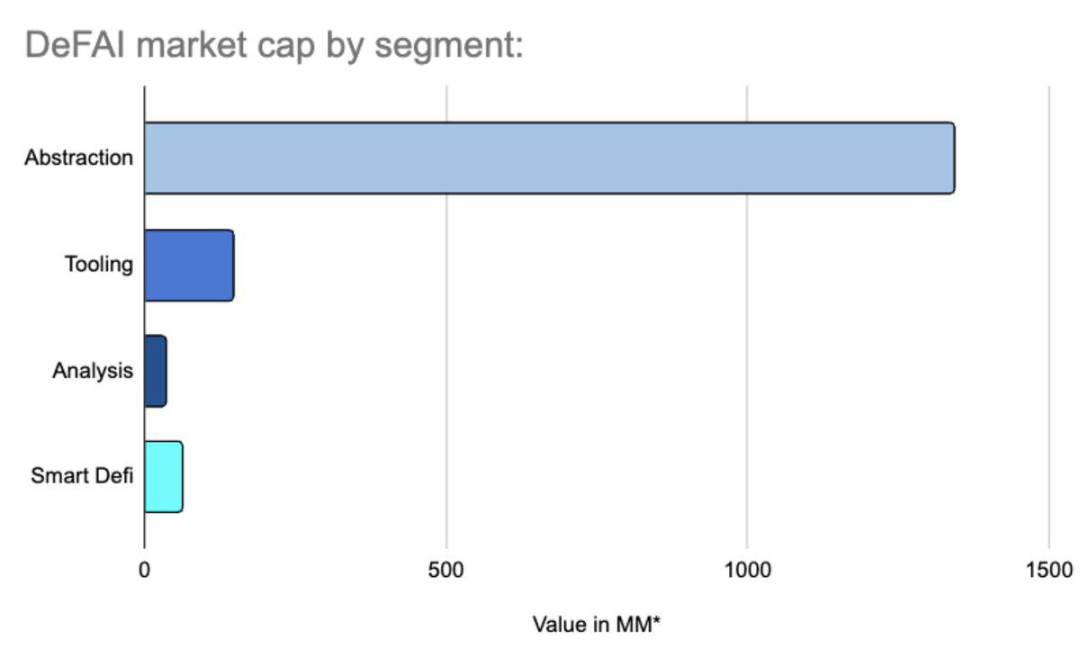
Valuation chart, a snapshot of the project obtained from @cookiedotfun earlier this month, is now much lower in valuation
Most DeFAI market value is concentrated in the "Abstract" category. Abstraction is mostly text-based alternative user experience (UX). This category is "low-hanging fruit" because it utilizes the application programming interface (API) of existing DeFi projects and the Large Language Model (LLM), which is logically limited and is mainly based on intent. Given the current number of projects and valuations in this field, it is very likely that the winner has emerged, and compared to other categories, I think there are limited opportunities here.
I also encourage investors to try these products. In my case, I found that most projects in the field of abstraction do not provide a good user experience.
Interestingly, this market structure creates some opportunities for traders…
The valuation of DeFAI has dropped sharply recently, and the sneer seems to be proven right... Product development takes time, and considering the stage the project is in, I think this valuation decline is mostly reasonable. That being said, as prices fall, people get bored and I believe there may be opportunities in the future for those who are paying attention to the market.
So, where is the opportunity?
First, I think most of the opportunities lie in tokens that have not been launched yet. That being said, these segments already exist and some projects are already online, to seize the opportunity, you have to be careful about the market and be prepared. To help determine the direction of focus, let’s review a framework for thinking about the DeFAI market.
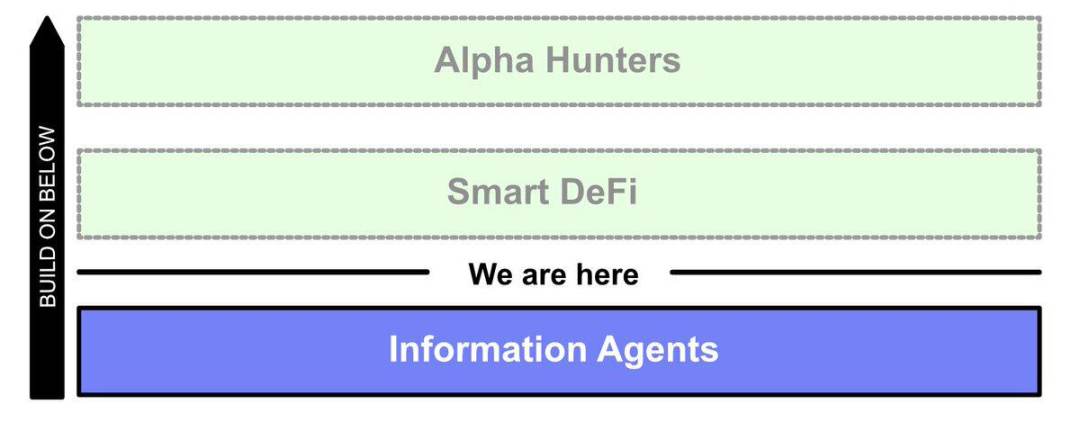
Information Agent
This is an era when AI agents mine information and complete simple intentions.
The large language model is very good at processing text and communicating with text. Since most AI agents are leveraging the APIs of existing models at this stage, their most powerful application scenario is natural language processing (NLP). I won't go into it in depth here, because there are a lot of other materials on this, but here are two advanced areas:
Alternative User Interfaces/Abstract: These are chat-based user interfaces that aggregate and abstract DeFi protocols and even blockchains. They can provide macro information, find projects and perform simple operations. For example, "I want to buy SOL -> Buy SOL through Jup". Ultimately, these tools will use existing DeFi primitives/aggregators and cross-chain bridges to perform operations. I guess the "winner" may have appeared, and we're likely to see the market consolidate into a few platforms. Growth will be reflected in improving AI and integration capabilities and expanding user base, which remains an unproven market. In my case, I'm not sure if the text-based interface will really improve the user experience of DeFi.
Analytical tools: These are auxiliary tools that help traders mine and process information. This is a diverse category, with some examples including code review, token analysis, and social sentiment analysis. Analytical tools will continue to evolve to become more complex and play an important role in the evolving cryptocurrency/AI ecosystem. Artificial intelligence-driven analytical tools compete in the same market as traditional analytical tools. Overall, there is still a lot of room for development in cryptocurrency analysis. I think segmented analytical tools will be able to gain more value than general analytical tools.
Projects worth paying attention to:
- Abstraction: griffain, neur, The Hive, Venice, etc...
- Analysis: Cookie DAO, Kaito AI, Hiero Terminal, etc.…
Smart DeFi
Turning from information to action, the ability to mine information and take action based on that information.
Currently, this is a $200 million market and I think it will eventually take up a large part of the DeFAI market. Assuming the market size is US$12 billion and "smart DeFi" accounts for 50%, then there is still a 30-fold opportunity in this segment. Again, I don't think the winner has yet to appear...
Where is the practicality (value)? Initially, practicality will come from continuous monitoring and automation, allowing users to take advantage of the tiny inefficiencies in the market that they might otherwise not notice or feel that they are too small to be worth the time spent. This market already exists. As the field develops, the large language model will enable the DeFAI protocol not only to be automated, but also to adapt and expand the market scope to further increase returns. Over time, the degree of improvement in returns will be synchronized with the development of intelligence, reasoning capabilities and infrastructure.
Teams that have succeeded in this field will have to build or use custom models, DeFi infrastructure and data pipelines. This deeper need for integration is why this field is underdeveloped compared to the field of abstraction. It takes time to build these things.
Smart DeFi is not a new market, but artificial intelligence can enhance and scale it. Examples of existing products include the revenue optimization projects Lulo, Carrott, and the aggregators Ranger and Jupiter.
The existing domain is the area where deterministic models perform well. For example, "The cheapest interest rate between protocols X is Y, so use Z". Ultimately, operations based on large language models may help elevate these protocols by providing alternative user experiences or enhanced information, but existing projects are unlikely to be subverted.
How will smart DeFi expand in this market?
Large language models are probabilistic. In fixed markets, this can lead to poor performance, for example, if you compare the trading price, the cheapest is always the best.
The probabilistic nature and the ability to process various types of information do provide advantages, which can allow DeFi to expand into new, more dynamic markets.
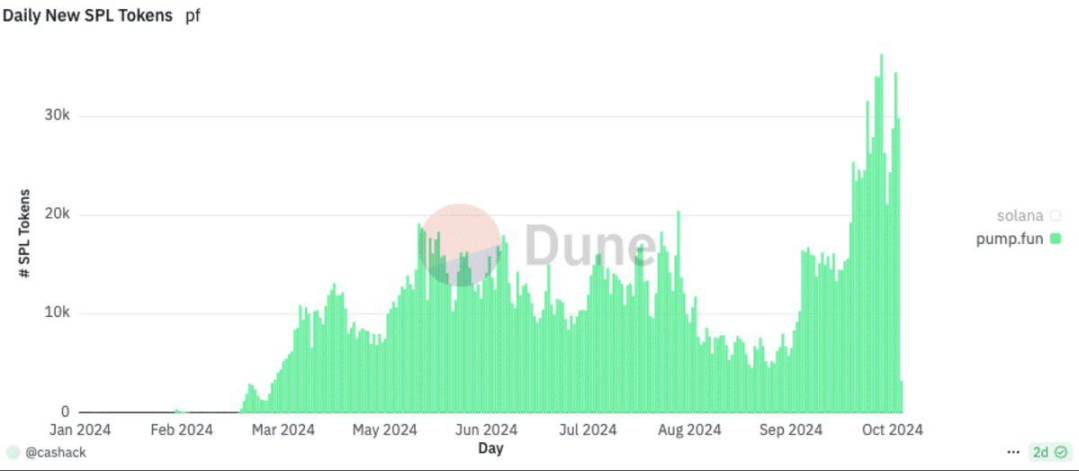
More than 50,000 new tokens are born every day. I know this data is a bit old, but this trend continues...
In the long tail part of the market, trading volume and value are constantly changing between new assets. Due to volatility, existing DeFi primitives are difficult to serve this category. As we continue to "tokenize the world", this market will continue to expand.
Furthermore, tokens are not equity, and tokens can be constructed/represented in a variety of different ways. The high diversity of assets in the market is another advantage for intelligent systems.
Smart DeFi can help DeFi expand to this market for the following reasons:
- Ability to mine/evaluate new assets
- Dynamically monitor, understand and act on new market narratives
- They can integrate social, on-chain and off-chain data and use reasoning to take multiple actions.
From a macro perspective, there are synergies, but where are the opportunities?
Let's take a look at a promising segment, Smart LPing.
Liquidity provision is difficult because each fund pool has different risk profiles and returns fluctuate greatly between different assets. Currently, based on user investment philosophy, there are some tools that can help configure assets, but the degree of composability/automation is limited.
The vision of liquidity providing agents is to dynamically optimize the benefits provided by liquidity by adjusting risk parameters and selecting asset/fund pools based on a combination of on-chain and social data. Eventually, a new asset may be created that dynamically reaps returns from the long-tail market, thereby improving market efficiency as a whole.

Raydium\'s handling fee can be used as an indicator of on-chain transaction volume
Why choose a native AI team?
Yes, it takes time to realize this vision. That being said, I believe native AI teams are more competitive in areas where the market is less efficient/absolute returns, as more returns can be attributed to intelligence. Native AI teams will be smaller so they can move faster and focus more on the "smart" factor.
Some of the teams I want to mention: Cleopetra, Alris agent and Voltr.
Other areas that I won’t go into in-depth include smart regular quota investments, transaction execution, and products based on social signals. As intelligence increases, the proportion of returns attributed to humans will begin to be eroded by artificial intelligence tools.
Project Plutus has shown interesting early results in smart limit orders, and I'm looking forward to testing it myself.
Next, Alpha Hunter
Let's see if an agent can generate alpha benefits.
Here are some common responses from some of the more professionals in the industry. While I agree that we are still far from this goal, I think it is ignorant to completely deny the Alpha agent. Believe in something...
It is difficult to generate alpha returns.
In traditional markets, hedge funds spend billions of dollars a year to work with the world’s smartest people to create an advantage. But systemic friction means that the cryptocurrency market is far less efficient than the traditional market, and because of this, it is more feasible for agents to generate alpha returns. New asset classes/narratives appear every week, meaning cryptocurrencies cannot directly apply the same strategy as traditional finance.
Why give up Alpha?
I firmly believe that "Alpha Hunter" will not be an innovation from 0 to 1, but will gradually emerge. Alpha gains will remain human-driven, assisted by AI for the foreseeable future. Over time, the reward will gradually be attributed to the agent. Once we reach a certain tipping point, we may see real "Alpha Hunter Agents" appearing, and they will hire or cooperate with humans.
Tokens will help launch, coordinate and integrate emerging ecosystems.
Two current protocols that use interesting methods:
- Almanak: Almanak integrates quality data pipelines, advanced risk engines, and artificial intelligence-driven agents to generate and execute a variety of financial strategies under human supervision. It is a proxy/policy platform that continuously recognizes Alpha gains and serves users in a secure, unmanaged environment.
- Allora: The Allora inference system intelligently aggregates and weighted artificial intelligence predictions based on real-time accuracy. Human participants play a role as workers, providing predictions and evaluating the quality of reasoning to perfect the systematic market forecast. The goal is to apply these forecasts to the market.
Crypto native teams dedicated to model development will also play a key role. Ultimately, intelligence is the key.
The protocols I like are: Pond (focused on developing encrypted native models with on-chain data) and Nous Research (they did a lot of work to help develop the first optimal model for decentralized training, and they also mentioned Explore Agents "Demand").
This field is still in its early stages, focusing on teams with potential to grow.
With the continued decline in the marginal cost of intelligence and the increasing number of newly created markets every day, agents are ready to embrace an emerging market segment that is fleeting for humans and too dynamic for robots. Believe in something.

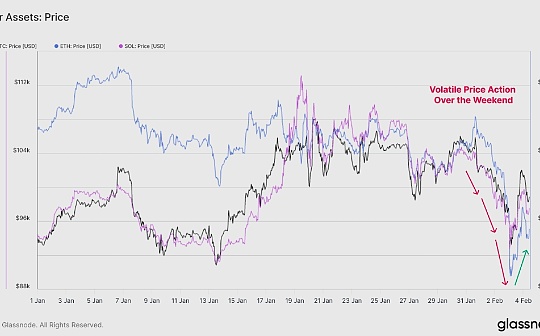
 jinse
jinse